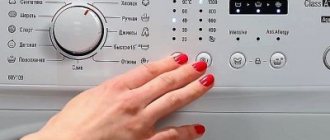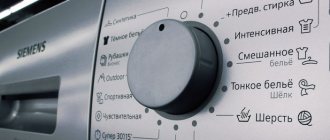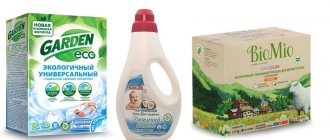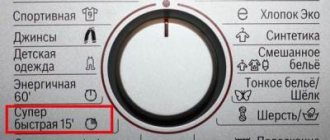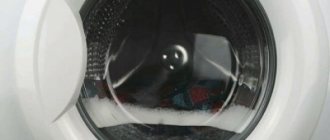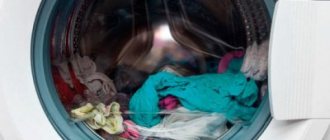Intensive wash, as the name suggests, is designed to process heavily soiled items.
This mode is included in the set of built-in programs for most washing machine manufacturers.
Despite the high quality of washing, the use of intensive has a number of limitations and a list of features of use.
What does this mode mean?
Vigorous processing means effective washing of difficult stains with high power of the washing machine. In order for dirty laundry to be washed efficiently, it must first be sorted (by color, type of material, condition, etc.).
Information from the product label about the processing features of each specific item is also taken into account. Taking into account all these criteria, a suitable mode is selected.
Intensive washing takes place even in more severe conditions than the “cotton” program.
Distinctive processing features:
- high temperature conditions (up to 95ºС);
- drum rotation at high speed.
Not all types of materials can be processed under such conditions. And it is advisable to use such washing only when the dirt is very strong and/or old. Linen and cotton tolerate this effect best.
Key Features
It is used in cases where it is necessary to wash heavily soiled items and if other more gentle modes are not able to wash the laundry. The very term “intensive washing” indicates that the automatic machine will work at the limit of its capabilities, consuming a lot of water, electrical energy and washing powder.
The process itself occurs in several stages, the temperature is extremely high, and the drum rotates as quickly as possible. These conditions help get rid of strong and stubborn stains. Only the most durable and unpretentious fabrics can withstand such a test, otherwise the item will either “shrink” or fade. In some models, this program is called “boiling”, which is not far from the truth.
Purpose and application features
The main purpose of such washing is the high-quality removal of contaminants from things that other modes present on the washing machine cannot cope with.
Since the things placed in the drum are very dirty, it is not worth filling the machine completely . The best option is to put half of the standard load into the drum, or even better - a quarter.
At the same time, it is also not worth starting a work cycle with a practically empty drum - the processing efficiency will be reduced.
This is due to the fact that in a tightly filled drum it will be more difficult for the detergent to dissolve. And the washing machine will not be able to turn them over properly during the washing process so that the impact on contamination is as strong as possible.
Intensive processing, in addition to heating water to high temperatures, also involves strong rotation of the drum . Not all materials can withstand high speeds either. The most persistent of them, which can be influenced with high energy, are linen and cotton.
In washing machines from different manufacturers, particularly effective washing may be designated differently. This circumstance can be clarified in the instructions for a specific model.
Eg:
- The program is signed with the words;
- in Samsung - there may be a verbal description and/or a schematic image of a T-shirt with spots;
- in Indesit - pictogram of a T-shirt with spots, etc.
If your existing washing machine does not automatically determine the intensity of drum rotation, then for effective washing you should focus on the following parameters:
- synthetics – 600 rpm;
- jeans – 800 rpm;
- cotton – from 1100 rpm.
Intensive processing is not suitable for damaged items and worn-out fabrics!
Intensive cycle in different brands of washing machines
In Bosch automatic machines, intensive washing is indicated by the symbol of a T-shirt with stains, sometimes signed as “Energetic”. In most models, you can select the temperature at which it will occur - it is 60°C or 90°C. Performed at a speed of 1200 rpm. Suitable for durable textiles made of cotton and linen, resistant to boiling and mechanical stress.
On the panel of a Samsung washing machine, the program in question is also indicated by a dirty T-shirt icon. Some new models have the “Intensive Eco Wash” function, which allows you to get rid of even heavy soiling in just 60-120 minutes. This option combines softness and intensity, and is suitable even for delicate fabrics. Sometimes Eco involves the use of powders with enzymes. Their active components perfectly break down proteins, fats and carbohydrates.
In the Indesit machines, in the standard programs section, there are three modes for removing stubborn stains, two of which are designed for linen and cotton. This is a cycle with a soak at 90°C and an option without soaking at a similar temperature. For synthetic fabrics there is a separate thorough cleaning mode at 60°C. At the same time, the design of most Indesit models allows you to adjust the automatically set water temperature and drum rotation speed.
In some Ariston automatic machines this cycle is designated as “Stain removal”. The water is heated to 90°C, spinning occurs at maximum speed, and the process takes 165 minutes. There is also an Antibacterial program, using which you don’t have to worry that pathogenic bacteria will remain on your things.
Whatever brand of machine you have, they are all similar when it comes to thoroughly removing dirt. Stubborn stains can only be washed in almost boiling water, at maximum speed and in no less than an hour and a half. Only cotton, linen and some synthetic products can withstand this test. If you take this important rule into account, then your favorite things will not lose their attractive appearance for a long time and will delight you with their cleanliness.
Execution steps
This processing mode has its own characteristics. The algorithm of actions for the SMA user should be as follows:
Place things in the drum based on a load of 25-50% of the maximum.- Pour the detergent into the compartment of the cuvette, which is designed for pre-washing.
- Pour the detergent into the compartment intended for the main cycle.
- If necessary, add the required product to the conditioner compartment.
- Select a program from the control panel.
- Start the job.
The total consumption of detergent will be twice as much as with normal processing.
Washing before washing
Pre-washing is often compared to soaking. However, this is not a completely fair comparison. This mode replaces manual washing of clothes. It is used if things are very dirty or have stubborn stains. For example, when you need to wash work clothes, a tablecloth accidentally spilled with drinks, or children's pants in which the child fell into a puddle.
How long does the cycle last?
The duration of the program depends on the manufacturer, model of the specific device and additional settings.
The washing time is influenced by the following factors:
- the drum is loaded with things;
- the volume of the drum itself;
- rate of water intake from the water supply;
- water heating temperature;
- the specified number of drum revolutions.
How long does the machine wash in this mode? Average indicators of processing stages (without reference to a specific SMA model):
- Soaking or pre-washing – 15-25 minutes, during which the dirt is effectively saturated with the detergent solution.
- Wash with the drum slowly rotating (15–30 min.).
- Rapid rotation of the drum, intensive washing at high temperature (on average 25-30 minutes).
- Slow drum rotation (up to 20 minutes).
- Rinsing.
- Intensive spin at high speeds.
On average, a full cycle ranges from an hour to 1.5 hours or even more. The exact time depends on the manufacturer of the equipment, the specific model of the automatic washing machine and some other factors.
At the end of the washing machine's operation, it should be given time to rest without immediately loading a new batch of laundry into the drum. Without filling the pre-treatment compartment with washing powder, intensive washing will not be effective.
What types of washing machines are there?
Manufacturers of washing machines produce products of different models. Each of them has its own characteristics, and they are all divided into three types:
- Activator machines or semi-automatic machines.
- Ultrasonic “washers”.
- Modern (standard) automatic machines.
Before choosing a suitable washing machine, you need to carefully study the information about it, reviews of those who have used it, and choose a model specifically for your tasks and requirements. And also according to your financial capabilities. Below are the advantages and disadvantages of all three types of washing machines.
An ultrasonic machine is a small round device that fits comfortably in your hand. Before starting work, it must be connected to an outlet. It is used mainly in the country, when there is no standard washing machine at hand, or in semi-camping conditions. The essence of its work is that before using such a device, the laundry is soaked in a soap solution, and then the machine itself turns on and the washing begins. After this, you will also have to rinse and wring out with your hands, and rinse the device itself and wipe it thoroughly. A dubious pleasure, but many people use it.
Semi-automatic machines are small, compact and weigh little. Such a machine can be mounted on the edge of the bathroom, and after washing, hidden in the pantry. But this is where the list of advantages ends, and continuous disadvantages begin. Before washing, you need to heat the water, pour it into the machine, and do not forget to stir the powder or other product into it. And only after that you can load dirty laundry into the washing machine. At the same time, if things are very dirty, you will have to change the water several times. If the fabric is thin and delicate, then during the washing process things may even be damaged. As soon as she finishes the job, the car needs to be thoroughly washed and dried.
Standard modern cars (automatic machines) are the most convenient. They are easy to use, load things, add powder, set up and you are good to go.
But you need to do this carefully and treat the machine with care. However, even the most careful use will not protect against wear of parts. Before you take your washing machine for repairs, you need to think: is it worth it? If the repair is under warranty, then the question disappears
But if the machine breaks down 2-3 years after the end of the warranty period, it’s worth thinking about: now one part is broken, another month later. If repairs cost a lot of money, you should think about buying a new washing machine. This type of washing machine will be considered next.
What is the water heating temperature?
Particularly effective processing of things should be carried out only at high temperatures.
This is a necessary condition for the effective removal of contaminants, including extensive or ingrained and old ones. As a rule, manufacturers set the temperature range within 90 - 95ºС .
Artificially lowering the processing temperature makes washing no longer so effective.
Advantages and disadvantages
Pre-washing in a washing machine is a delicate process; it does not harm even capricious fabrics. Any item that can be washed in a machine can be subjected to this procedure.
- The advantage of using the program is efficiency.
Any laundry that is first washed in cool and then in hot water will be cleaner than with normal washing. Using this mode in the machine, you will be sure that all the dirt will go down the drain and you will not have to rewash things.
- The disadvantage is the inability to save resources.
When using the additional function, the washing machine uses more electricity and water than with the standard program. It is for this reason that many housewives prefer to wash things by hand.
There is one more parameter - time, which can be written down as both pros and cons. On the one hand, a machine with the function turned on takes longer to wash. On the other hand, he does the manual work for you. You can do something else while doing laundry.
Advantages and disadvantages
Intensive wash is one of the useful programs when you need to tidy up very dirty items. This mode has its strengths and weaknesses, which should be taken into account in advance, before starting work.
The advantages include the following:
- effective removal of even difficult stains, including old ones;
- Suitable for dense materials that can withstand high temperatures.
The disadvantages include the following circumstances:
- The option may not be used for all types of fabrics;
- intensive processing accelerates material wear;
- washing at high temperatures helps wash out colors from prints;
- this is not a short program;
- the mode accelerates the wear of the washing machine elements;
- the drum cannot be filled to the maximum, so fewer things are processed in one cycle;
- It is advisable to use a particularly effective washing program not often - a maximum of 2 times a month;
- washing powder consumption doubles;
- things after processing are very wrinkled;
- the program is executed with a high consumption of resources.
When choosing a detergent for treatment, it must be taken into account that the powder must be suitable for washing at high temperatures. This information is displayed on the packaging.
Frequent use of the intensive mode can harm the washing machine itself, so it is recommended to use this functionality not often, and only when absolutely necessary.
How often do you turn on extreme sports?
The optimal frequency of extreme washing is no more than 2-3 times a month. Not all users are familiar with this mode and not everyone knows in what cases to use it. There is nothing bad for the machine that the enhanced washing function is not activated. The downside here is for users who cannot properly wash heavily soiled jeans or T-shirts. If you do not exceed the specified washing frequency, the SMA will not be affected.
Use for delicate fabrics
If you need to wash a soiled item made of wool, silk, tulle or other delicate material, you cannot use the “intensive wash” mode of the washing machine.
In this case, alternative processing will be the way out:
- Pre-soaking.
- Use a suitable stain remover.
- Separate washing of problem areas, etc.
It is important:
- use only the appropriate temperature regime (it, like other useful information, is indicated on the label of the item);
- carefully choose household chemicals;
- vary the force of impact on the material;
- Do not expose the material to detergent, water or mechanical action for a long time.
In most cases, even delicate items can be washed without negative consequences if you follow the rules.
How to choose the right program?
The advantage of modern SMAs over their less “smart” predecessors is the very individual approach for which any process is so valued. All things that can be washed in a washing machine are divided according to a number of criteria:
- by color - white and colored;
- by material - cotton, linen, wool, delicate fabrics;
- to size;
- according to the degree of contamination.
Depending on the combination of the above criteria, the optimal mode is selected. For example, the conditions in which white cotton sheets can be washed will be disastrous when applied to delicate lycra or organza.
The washing program is set after assessing all the criteria for a specific item or group of items with similar characteristics. Labels attached to all industrial products will help with this. On these labels, using symbols, the process conditions are indicated - temperature, use of detergents, and some other details. For example, an icon depicting a hand dipped in water means that the product can be washed either by hand or set to “hand wash” in the SMA. It is unacceptable to wash such products under extreme conditions typical of the intensive washing method.
What are they?
On the market of automatic washing machines, the greatest preference is given to equipment with a maximum range of functions and an abundance of special programs, because this helps to achieve brilliant washing results and prevent damage to things. You must be able to correctly use one or another type of program and wisely use the capabilities of the machine. First you need to figure out what type of washing modes are classified.
Economical programs
Here the choice depends on what the housewife would prefer to save: water, time, electricity or washing powder. Savings are achieved by reducing heating or water waste, as well as reducing the time interval.
This type of classification is characterized by a high temperature regime, additional rinsing of washed clothes and is intended for people who need careful treatment of their things: allergy sufferers or children.
There are 3 main categories into which washing modes are divided:
- Programs that adjust the process depending on the type of laundry. A properly selected cycle will not ruin a thin silk item, will keep a sweater from shrinking, or will remove stubborn stains from thick denim.
- Programs designed to save water and electricity. The quality of washing in such cases does not suffer, but the process takes longer. Or vice versa - only light stains can be removed, but the program is much faster.
- Target programs. Disinfection of linen, easier ironing, hypoallergenic, etc.
Depending on the manufacturer, there will be icons and/or text placed on the control panel to let you know what the wash cycles on the washing machine do. In the case of text, it’s easier to understand, but if there are only icons, you’ll have to look at the instructions, because different companies have their own notes. If the instructions are lost, you can find them on the Internet, on the website of the unit manufacturer.
Designations that are almost identical for all devices:
- basin with hand, hand near clothes - manual;
- snail - spin;
- snowflake - cold;
- iron - for easy ironing;
- yarn - for wool;
- plant - cotton;
- pelvis with wavy lines or stopwatch - accelerated cycle;
- basin with downward arrow - draining water;
- pelvis with two vertical lines is a common program.
Washing rules
Choosing the right modes protects things from damage and rapid aging. Even the smartest and most expensive automatic machine will not be able to give things cleanliness and shine if the owner has not been able to prepare it and the laundry for work and set the necessary conditions.
Rules for preparing laundry for washing:
- Pre-sort items according to fabric color, composition and level of contamination.
- Bed linen is freed from feathers, debris and threads accumulated in the corners.
- Check pockets and empty them of all objects and dust.
- Fasten all the buttons. The zippers are fastened and secured.
- Separate belts, hoods, and other removable parts. Remove items that cannot be washed.
- All parts of one garment should be washed together so that they have the same appearance after washing. Even if individual parts do not need to be washed, it is better to load them with the rest.
- The sewn beads are secured. Decorative elements that may fly off are sewn up with thin fabric.
- Pants, skirts, knitted items are turned inside out.
- For complex products, special mesh bags are used.
- If you need to wash bulky items (jackets, blankets), you can first lightly moisten them with water - this makes it easier to place them in the drum.
- To facilitate the operation of the machine, high-quality washing and rinsing, wash items of different sizes together - large and small.
- Load the machine within the recommended limits, do not push excess things with your knee.
- They use detergents for automatic machines and according to the type of laundry.
- Powders and gels are placed in the appropriate compartments without exceeding the norm.
- Set the desired mode, check the presence of cold water in the tap and start the wash.
A few more important recommendations:
- washed laundry should be immediately removed from the drum and hung up - this way things will wrinkle less and ironing will be easier;
- if there are traces of powder left in the laundry, you can start rinsing and spinning;
- Liquid and capsule detergents are better rinsed out of things.
You should not use excessive amounts of detergent - this will not improve the quality of washing, it will simply make rinsing more difficult.
Activation and operation of the function
Not long ago, Samsung introduced an intensive soaking program. A technology in which even very dirty clothes become clean without any effort on the part of housewives. Now you don’t need to rub stubborn stains for a long time, experiment with stain removers and wait for 2-4 hours - the washing machine copes with the task quickly, efficiently and automatically.
When intensively soaked in Samsung washing machines, clothes soak in whipped active foam, thanks to ecobubble technology.
The soaking program is started by pressing the “Bubble Soak” button. To understand what it is and how it works, it is worth following the main stages of this program.
- The first stage is soaking with detergent. After the user places the soiled item in the drum and turns on intensive soaking, the ecobubble generator (developed by Samsung) turns the detergent into active foam. Through the holes, the foam mixture penetrates the fabric structure and begins to gently destroy stains from the inside.
- The second stage is a mini-wash. A little water is added, the drum is rotated for a while at low speeds, after which the detergent dissolves more strongly and begins to act more actively.
- The third stage is direct soaking. The clothes remain in bubbles of well-dissolved product. The foam penetrates deep into the fibers of the fabric, completely pushing dirt out of the material.
- The fourth stage is repeated scrolling. The drum rotates periodically, allowing the foam to “envelop” the entire thing.
Thanks to ecobubble, the effect of washing powder or gel increases significantly, since the bubbles quickly cleanse dirt, acting as gently and carefully as possible. Thanks to the foam and periodic rotation of the drum, intensive soaking on Samsung machines helps to defeat even the most difficult stains, for example, from blood, red wine, grass or coffee.
The housewife can vary the soaking time, depending on the degree of contamination of the item. As a rule, a standard 30-40 minute cycle is enough. The main thing is not to forget to add detergent to two compartments of the powder receptacle at once. After preliminary cleansing, it is easy to start the main wash, which will smoothly transition into rinsing and spinning.
How to iron and dry clothes after washing
Wäschetrockner, BaWa 004
It is worth noting that gentle washing alone is not enough to preserve the original appearance of products. It is recommended to dry and iron clothes properly.
Tips for drying delicate materials:
- if you did not use a spinner, hang things on hangers over the bathtub and let the water drain;
- Never dry wet items on a line in a bent state or attach them with clothespins;
- either hang the product on hangers or lay it out on a horizontal, preferably mesh, surface;
- to speed up the process, do not place clothes on a radiator or other sources of artificial heat;
- Do not leave light-colored laundry to dry in the sun; try to hang the items in the shade;
- Place the guipure and lace on a flat horizontal surface and cover with absorbent material.
Tips for ironing delicate fabrics:
- for processing, use a high-quality iron with a clean and smooth sole;
- first, try ironing an inconspicuous area of the material with a slightly warm iron, see if the treated area is deformed;
- iron wool at a maximum of 180 degrees only through slightly damp cotton fabric;
- Either do not iron synthetics at all, or set the iron temperature to 110 to 130 degrees, and process only through cotton fabric;
- Iron the organza through a thick sheet of paper at a temperature of 100 to 110 degrees;
- iron silk clothes from the inside out slightly damp, setting the iron temperature to a maximum of 160 degrees; if the material is dry, to prevent streaks from appearing, do not spray the fabric, but moisten it by wrapping it in a damp towel;
- It is better not to iron velvet items, but to treat them with steam from a steam generator or by hanging the item over a bathtub with hot water;
- products made of nylon and elastane cannot be ironed;
If you are unsure of the type and origin of the material, look at the label on the product. The crossed out iron icon means that ironing clothes is prohibited, and the number of dots in the center indicates the degree of heating of the device.
Installation and connection
To start using an automatic washing machine, it is not enough to plug it into a power outlet; you will need the services of a mechanic who will connect at least the inlet hose to the water supply. If this type of equipment has already been installed in the apartment, then the services of a locksmith are not necessary, just connect everything to the same place. You don’t have to attach the drain hose to the sewer at all; it’s enough to place it in the bathroom, for example, while washing.
At the same stage, we connect the power cord to the network; note that the outlet itself must be connected to a separate circuit breaker. This way, you will avoid unwanted equipment shutdowns that may occur due to overvoltage. If you can’t activate the washing machine yourself, call the LG service center, the local specialists will cope with any task in a matter of minutes.
What fabric can be washed on an intensive cycle?
Not all fabrics can be washed intensively
Users of washing machines should be aware that not every fabric can withstand high temperatures and high-speed mechanical torsion in the drum. The clothing label should contain a recommendation about using an intensive cycle - this is the information that needs to be taken into account when choosing a washing program. What types of fabrics are suitable:
- cotton or polyester;
- natural linen;
- artificial fabric or synthetics.
At the same time, you need to know that intensive washing of clothes occurs practically in boiling water - the temperature in the tank reaches 90-95 degrees. Experts say: things will be washed more thoroughly if the washing machine drum is filled to a maximum of 2/3 of the full load. But the minimum value must be at least 1/4, otherwise the operation is pointless.
Smart Diagnosis
Since we are talking about “smart” LG appliances, we cannot fail to mention Smart Diagnosis, a function that allows the machine to automatically determine the cause of the malfunction and send this data to the service center. It is enough to activate the function and hold your mobile phone to the corresponding icon on the panel, after which all the necessary data will be sent to specialists.
Almost all modern washing machines display the washing time on an interactive display. The user, by selecting the desired mode and additional options, immediately sees how long it will take the washing unit to complete the task. But, there are a number of machines that do not have a display in their design. In this case, the user cannot know the exact time required for the washing device to complete the task.
Additional functions
Most modern models of automatic machines contain a large set of additional functions that help solve all problems and satisfy the various requirements of housewives.
Delay mode
A convenient way to turn on the washing machine before going to work and take out the finished clothes when you come home in the evening. At the same time, they will not wait for the owner in the drum for several hours, already washed (crumpled and compressed).
It is important to load the detergent completely and set the clock to a delay start mode.
You need to read the instructions for the washing machine. First we set the current time and then program it for the desired turn-on time.
Video on how to delay automatic washing
Night
When using the night mode, the sound signal is turned off, as well as the spin cycle, which is noisy and can wake up household members and neighbors.
Water level control
When monitoring the required amount of water, the machine itself decides how much liquid to pour into the drum based on the weight and volume of the load in order to better wash and rinse things.
Spin balancing
The mode ensures uniform distribution of laundry during spinning and, if necessary, slows down the rotation of the drum by adjusting the speed. A very convenient tool for heavy loads, it prevents excessive vibration and movement of the device from its place.
Water clarity control
This mode is convenient to use for children's clothing and if household members are allergic to detergents. The machine determines whether the items have been rinsed sufficiently or whether the water is not clear enough and contains soap. If necessary, perform additional rinsing.
Spin
The function allows you to simply spin out wet items by selecting the spin force (rpm). You can quickly spin out hand-washed items, as well as those that did not leave the machine dry enough.
This function allows for simple (without additional operations) removal of water from the drum. For example, when a program crashes and things are retrieved.
Rinse and drain
A convenient way to simply rinse things and drain the water. Can be used if bad powder remains on the laundry after washing and rinsing.
Disabling spin
It is necessary to turn off the spin cycle when washing many items. For example, it is recommended not to wring linen items to avoid severe creasing, which makes ironing difficult. The machine simply washes, rinses and drains the water.
Extra rinse
The function allows you to rinse things more efficiently by adding water again and performing a full rinse cycle.
Easy ironing
Things wrinkle in the drum, mainly when spinning at high speeds. This mode (anti-crease protection) makes the push-up less aggressive and reduces the drum rotation speed. The laundry wrinkles less, but is less dry. You will have to dry it yourself, but it will be easier to iron.

